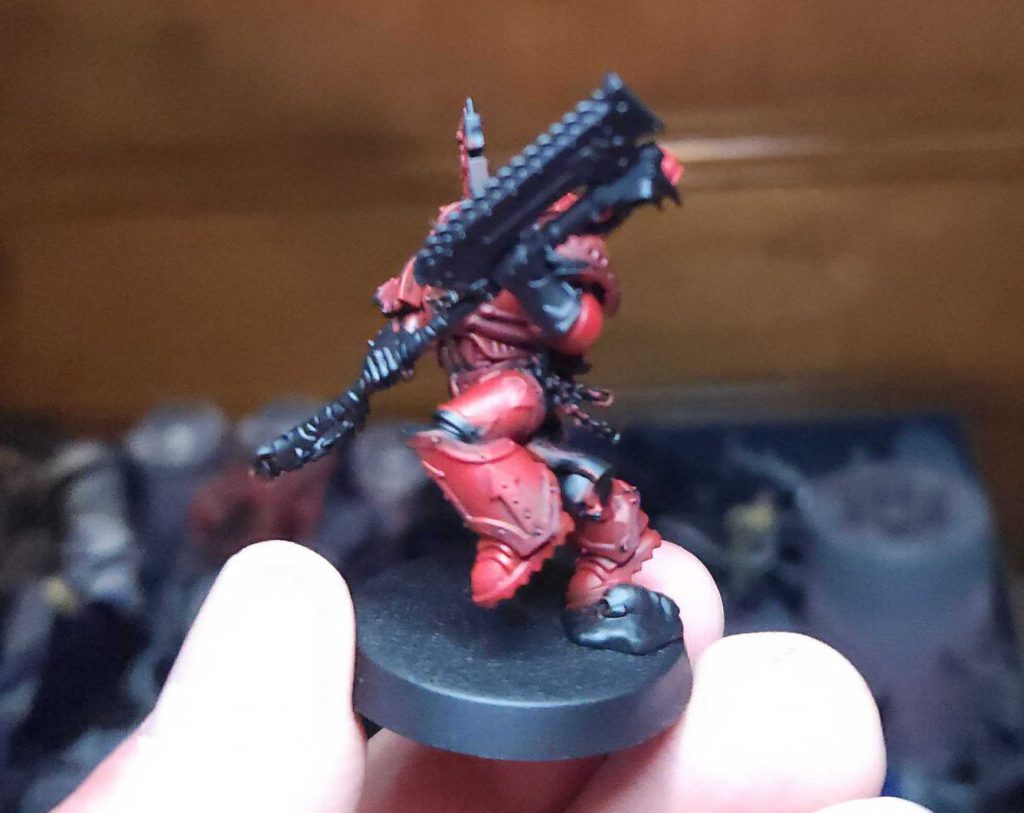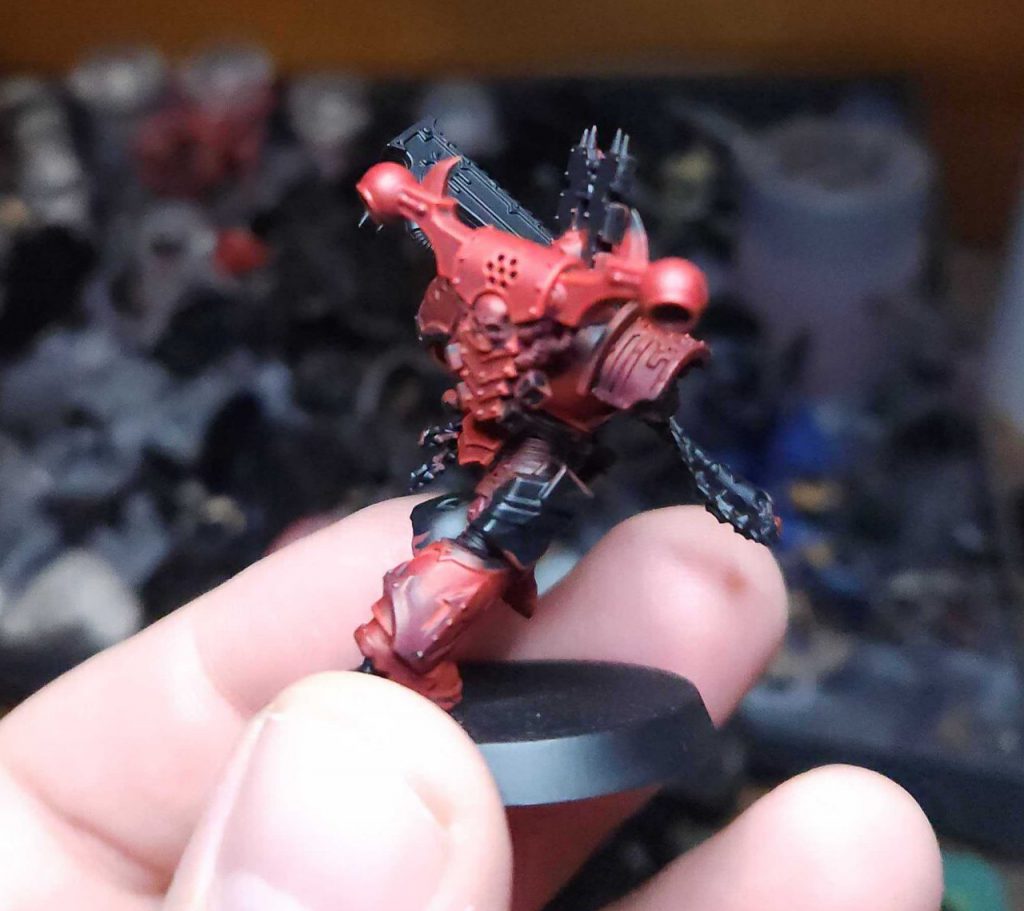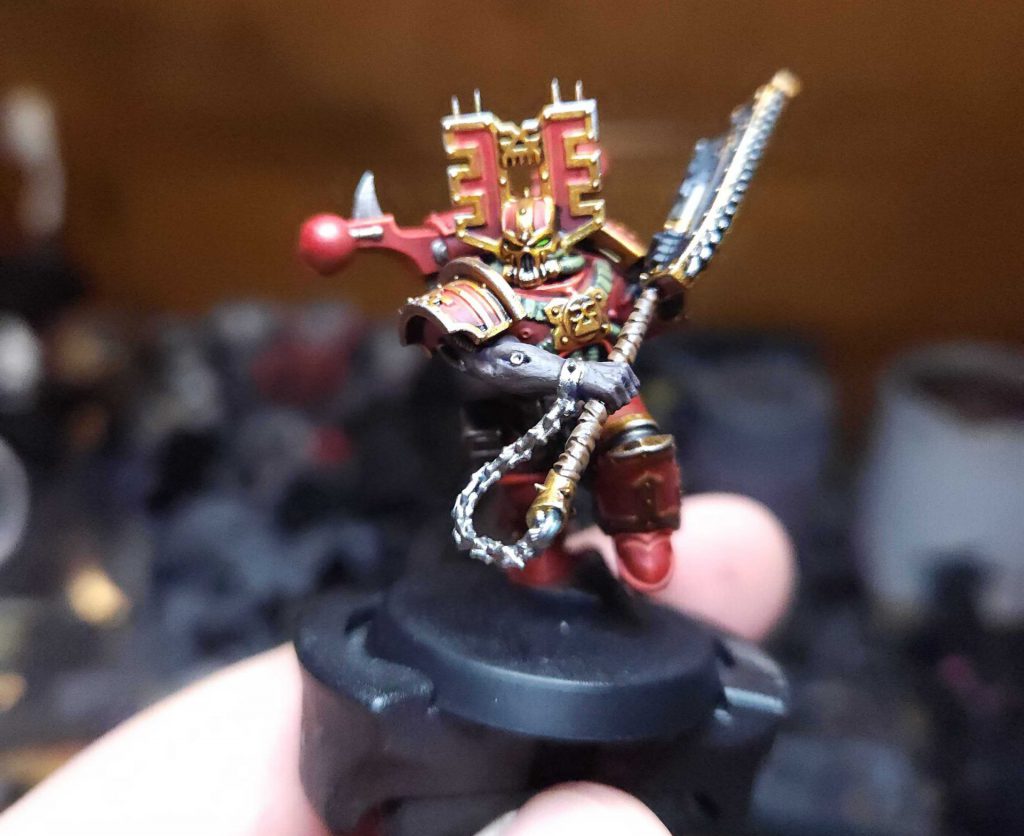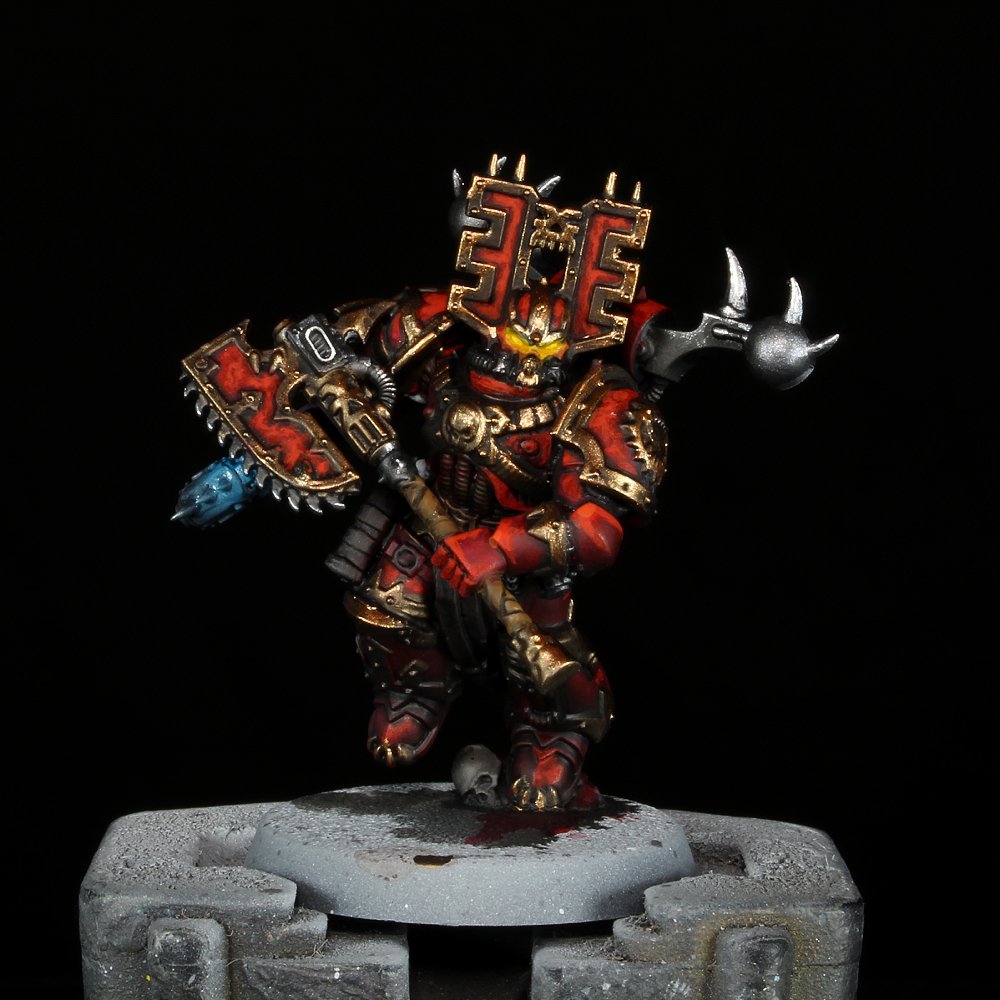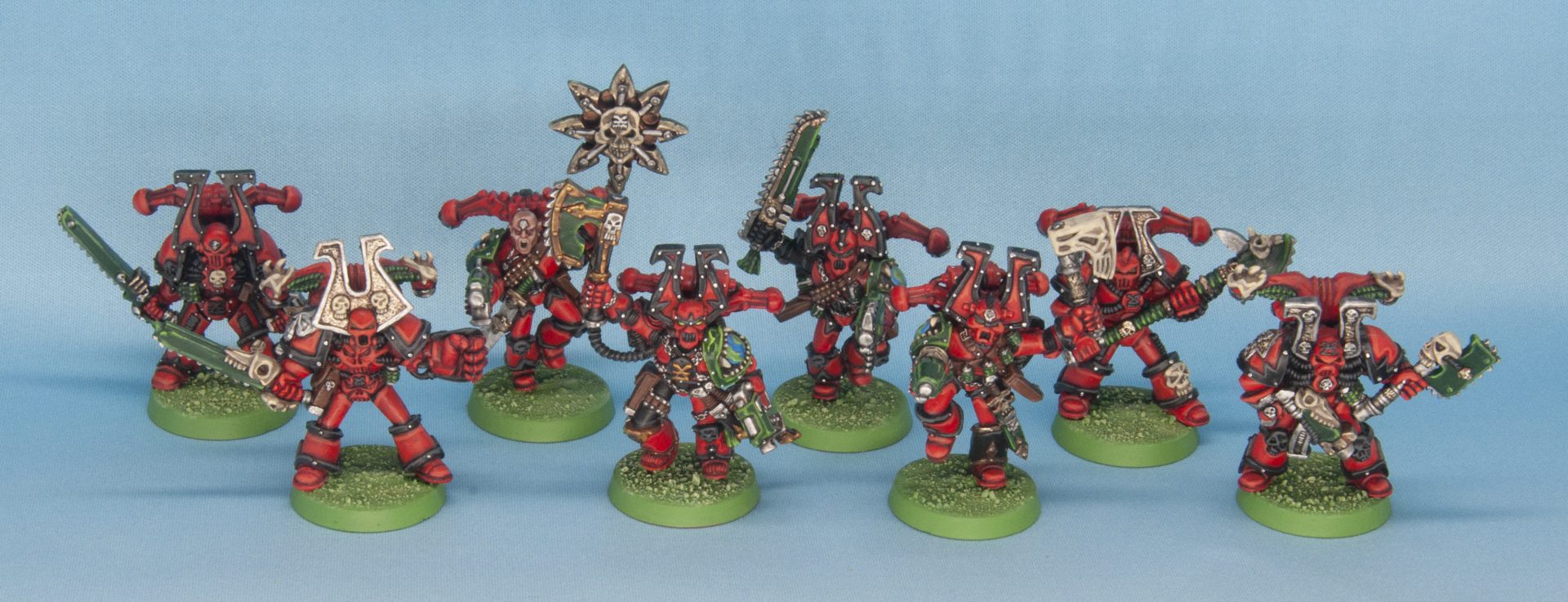In our How to Paint Everything series we look at how to paint well, everything, with different techniques and approaches from different painters. In this article we’re looking at how to paint the blood-crazed warriors of the XII legion, the World Eaters.
The World Eaters were already known for their savagery before the discovery of their Primarch, Angron. As the War Dogs they were brutal warriors known for their combat prowess and emphasis on violence over finesse. After the discovery of their primarch, they were renamed the World Eaters in honour of Angron’s former gladiator compatriots, who had been called “the eaters of cities” during their rampage across Nuceria. Under Angron’s leadership, the legion descended further into violent madness. They began implanting warriors with their own crude versions of the Butcher’s Nails, arcane technological devices which connect directly into the pleasure centers of a warrior’s brain and drive them to violent impulses.
When Horus rebelled the World Eaters were quick to follow and descended upon the Imperium in a bloody frenzy, destroying worlds and butchering their former comrades. Following the fighting on Terra, the World Eaters retreated into the Eye of Terror with the other legions. When infighting broke out, the World Eaters finally splintered during the fighting on Skalathrax thanks to the actions of Kharn the Betrayer. Since then they’ve operated as a series of warbands.
Where to Read More
There are a few books about the World Eaters if you’re interested in more backstory on the legion. While the books about Angron are some of the best, here are some options which don’t feature the Red Angel.
- Kharn, Eater of Worlds by Anthony Reynolds follows the World Eaters in the wake of the Heresy as they look for a new leader.
- The Red Path is an anthology of short stories following Kharn and the World Eaters in the early days of the 13th Black Crusade.
Painting the World Eaters
The World Eaters have a fairly simple paint scheme – red armor with brass or gold trim. That said, keeping the army interesting visually with a simple scheme can be a bit of a challenge.
Related Articles
- If you’re looking for advice on how to paint Angron, the World Eaters’ Daemon primarch, you can find that article here.
- World Eaters armies frequently charge into battle alongside Khorne Daemons. You can find more on how to paint them here.
TheChirurgeon’s Method
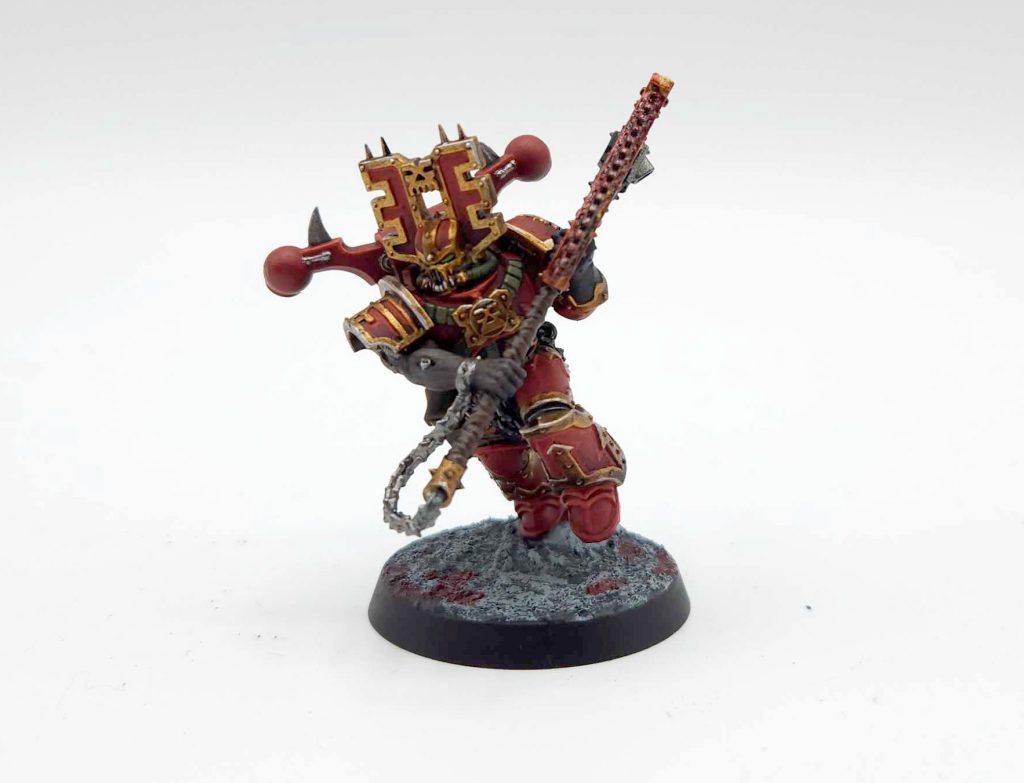
My World Eaters scheme is pretty simple, and it resembles the older 2nd edition scheme in some ways – namely that I like to do green power cables.
I start by priming the model black, then painting the armor panels with Khorne Red. This is the base color I use for the armor and my goal is to work it up to a brighter color. So my next step is to add a layer of Mephiston Red, then wash that with Carroburg Crimson, then highlight again with 2-3 thin coats of Mephiston Red again, working up to a brighter color.
My goal here is to get a nice fade going on the models. I’ll then use Carroburg to darken the edges around the armor trim.
Next comes highlights. In my first round of highlights I do edge highlight with Evil Sunz Scarlet, doing both edges and a thin line around the trim on the armor. Once that’s done I’ll do a second pass, hitting some of the corners and most extreme areas with a thin line/touch of Wild Rider Red to add a second level of detail.
The cables I do green. Specifically Castellan Green washed with Coelia Greenshade and highlighted with Castellan Green, then Death World Forest and Death Guard Green.
Next comes the gold trim. This is just Retributor Armour washed with Agrax Earthshade and highlighted with Runefang Steel (or any other light silver color).
After this it’s just some odds and ends. I did Gorthor Brown with an Agrax wash for the leather parts and Leadbelcher for the metal bits. On my World Eaters I usually add Blood for the Blood God to their weapons to create some gore effects.
And that’s pretty much it! Paint the rivets, edge highlight a bit more, do the base, and you’re done. It’s a relatively easy scheme to pull off, and the real value comes out of making that Khorne Red -> Mephiston fade work.
ThatGobbo’s Method

This paint process is based on the official scheme using a mix of Contrast paints, oil washes, and opaque metallics for a quick efficient workflow. I start off with a zenithal prime using a gray base and white sprayed from above.

With the primed miniature I use Baal Red Contrast paint for armor to start with a really bright basecoat. This will get darkened when I use a black oil wash after the basecoats. Baal Red gives a great saturated red but has a tendency to come out looking pink if it’s diluted at all with water. A second coat can fix any issues with that.
For the basecoats of the metallics I use Pro Acryl Bronze and Pro Acryl Dark Silver. These have amazing coverage and go down in one coat over white with no issues. Lastly is the leather details which I paint with Wyldwood contrast paint for a nice dark brown.

Now that the basecoats are finished I wait for everything to dry and then give a generous oil wash of Tamiya Panel Liner Accent Black. There were some areas that were flooded so a bit of dabbing with a clean brush helps pull that excess wash away. I turn on a desk fan to blow over the wet model and wait for the oil wash to dry.
Once the model is dry I need to spray a topcoat before I can go back in and paint the highlights in acrylic. Without a topcoat over the oil wash acrylic paint has the tendency to bead up. I use Vallejo Premium Satin Varnish.

With the model now prepped for highlights I use a series of red paints to highlight the armor. Areas without edge highlights, like the axe and helmet, get a mix of stippling and uneven brush strokes that fill the space. This texture helps give the impression that the armor is rough after decades or centuries of battle. The red paints I used in order of brightness are Pro Acryl Bold Pyrrote Red, Vallejo Model Color Vermillion, and Vallejo Game Color Hot Orange.
The metallic highlights used were Pro Acryl Copper and Vallejo Game Color Chainmail. For these I wipe a bit of the paint off on a paper towel before running the brush against the upper surfaces of the metals areas. It’s similar to a drybrush technique. The leather bits were highlighted with Vallejo Flat Earth.
I wanted to do some fun glow effects for the eyes and the plasma pistol. For the eyes I used a thinned Pro Acryl Titanium White on the eyes and the surrounding areas then painted over it with Imperial Fist contrast paint. Using a small brush I go over the eye lenses again in white and a thinned layer of the yellow contrast in order to make them brighter than the glow.
Similarly with the plasma pistol, I first paint the plasma coils in white. Then with my detail airbrush I spray white around the coils (you can also do this by hand with thinned white paint). I spray Frostheart Contrast paint over the area. I go over the plasma coils again in white and a thinned layer of the blue contrast so that it’s brighter than the surrounding area. Finally I highlight the corners of the plasma coils with white.
There’s other little details that can be painted but this is my stopping point for a non-display miniature. This is the general workflow I use for most of my miniatures and I find that it is a nice mix of speed and detail for me.
Dylan Gould’s Method
Dylan’s got a much more retro style that follows the classic ‘Eavy Metal paint scheme from the 2nd edition Codex: Chaos Space Marines. This paint scheme is notable for featuring much heavier amounts of black, often opting for black trim with gold rivets, and heavy use of an olive green accent color.
- Prime White
- Spray Red (I used AP Daemonic Red spray)
- Wash entire model with Agrax Wash (I use AP Strong Tone)
- Highlight red armor with Blood Red
- Highlight with Wild Rider Red
- Paint all Black and Metallic areas with Black
- Highlight Black with Codex Grey and a 1:1 Mix of Codex and White
- Paint Green with Dark Angels Green
- Highlight Green with Snot Green and then Scorpion Green.
- Base bone with Khemri Brown.
- Highlight with Khemri-Bleached Bine and add some White for the final highlight.
- Paint metallics with Chainmail (AP Plate Metal) and Retributor Armor
- Wash metals with Armor wash (AP Dark Tone)
- Paint bases Goblin Green
- Drybrush bases with Underhive Ash
Jack Hunter’s Heresy-Era World Eaters
The classic Heresy-era paint scheme for the world eaters isn’t red, it’s white with blue pauldrons. When Jack picked up the Legionaries kill team from Kill Team: Nachmund, he chose to go with a more classic look.

I started out by keeping the shoulder pauldrons separate during assembly, as this would let me airbrush them a different color than the armor without needing to do any annoying masking. I primed the pauldrons black, then basecoat them with Reaper Ultramarine Shadow. I covered almost the entirety of the pauldron with Reaper Ultramarine Blue, then most of the pad with Reaper Ultramarine Highlight. As the pads don’t have any seams on them, I didn’t need to wash them with anything – a little overspill when I wash the trim or spikes will accomplish all the separation I need.
The white armor got primed with Stynylrez Grey, and an initial coat of Vallejo Model Air White Grey was applied. I built up highlights with Vallejo Model Air Insignia White and Vallejo Model Air White (using the final pure white only very sparingly). If I was doing these again I’d probably use ProAcryl Titanium White instead. It’s not a different color, but it’s the nicest white I’ve used and I need to sing its praises everywhere. I hit them all with a Satin Varnish at this point – you can make satin by mixing gloss and matte roughly 50:50.
After the airbrushing, I did a rough oil wash of Burnt Umber with a tiny bit of Lamp Black mixed in. I kept it fairly thick, thin enough to spread easily but I didn’t want it completely flowing off surfaces. After some dry time (about an hour, but this will vary substantially depending on temperature, humidity, thickness of your wash, and your thinning medium) I took a lint-free rag and buffed most of the wash back off. The satin varnish ensured a bit stuck around to tint the surface, but it was mostly back to white. My goal here was to end up with a very warm toned white to contrast with the cool blues of the shoulder pads.
I then weathered the hell out of them with Rhinox Hide on a sponge, hitting both the shoulder pads and the white armor, concentrating on wear areas – knees, hands, and elbows mainly.
With the white armor and blue pauldrons complete, I first painted the trim black, then with Scale 75 Victorian Brass. All the trim got a wash with Agrax Earthshade, then was built back up with another pass of Victorian Brass and highlighted with Scale 75 Citrine Alchemy.
Leather and wood areas were painted with Vallejo Model Color German Camo Black Brown, an Agrax Earthshade wash, then streaky edge highlights in Vallejo Model Color Burnt Umber and Vallejo Model Color Flat Earth.
With that, all the key areas were done, and I could move on to painting all the random small details, trying to mainly stay in the warmer tones and leaving cool tones for the shoulder pads.
Have any questions or feedback? Drop us a note in the comments below or email us at contact@goonhammer.com.


